Hoya Watering Guide & How To Spot Watering Problems
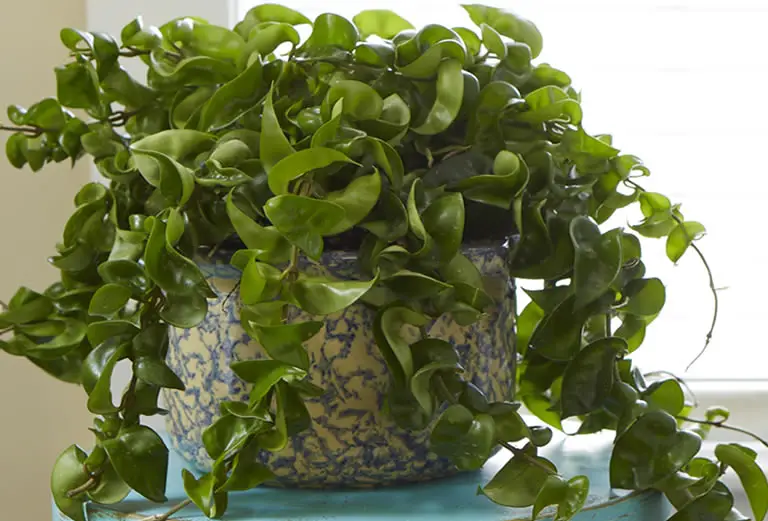
I have covered the Hoya plant many times on this site and I have discovered from my website readers that a recurring theme causes concern for a great many Hoya houseplant owners. More than anything else it is the watering routine needed for this semi-succulent that causes the most confusion.
So, in this article I will show you clearly just how much water your Hoya needs, how often you should be watering it, how to water it and I also look at the problems caused by underwatering and overwatering.
Table of Contents
The Essentials Of Hoya Watering
The Hoya plant is often called a succulent but, while it is closer to a succulent than it is to a non-succulent, strictly speaking Hoya are not succulents. Hoyas are semi-succulents and this distinction is important when it comes to watering the plant. How often should you water a Hoya plant?
You should water your Hoya only once the top layer of soil has dried out. For an average Hoya houseplant this will be between 2 – 3 weeks. It is always advisable to check moisture levels in the soil before watering though.
Before I elaborate on the ideal watering routine you need for a Hoya I need to first briefly touch on the type of soil this plant requires as it is directly related to its watering needs.
Hoyas are considered to be semi-succulents because, like succulents, they retain water in their leaves but, unlike succulents, they derive their moisture and nutrients mostly from the air.
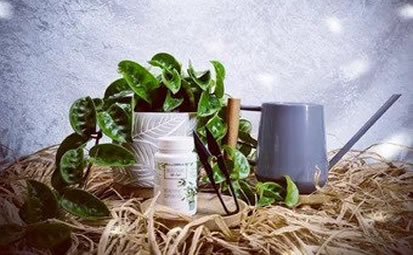
As I have pointed out about Hoya in our Hindu rope plant care guide, because this semi-succulent plant is epiphytic and relies on another plant to grow, it has a root system that requires much more airflow than regular terrestrial plants (plants that grow in the ground). It also requires a fast-draining soil so that moisture is never locked in the soil.
This means a Hoya requires a specific type of soil.
You may be wondering why I am talking about Hoya soil in an article about Hoya watering, but bear with me because it is an important consideration when it comes to the watering of this type of plant.
Your Hoya must be planted in a soil that allows for good airflow to the roots and it absolutely must have fast-drainage! You can get your watering routine 100% correct but still damage your plant because it is potted in the wrong soil that retains too much moisture. read more about soil type here.
Why you should never guess or follow a strict watering routine with Hoya
When I grow Hoya I never guestimate when the plant needs to be watered. I always check the moisture levels in the soil until I know for certain what the specific plant’s watering needs are.
I only ever water my Hoya when the top 1½ inches of soil is dry. I never guess how much moisture there is in the soil and instead check the moisture levels before reaching for the watering can.
Although I have a lot of experience with succulents and semi-succulents I never guess when it comes to their watering needs. I always check the moisture levels in the soil for several weeks until I know for sure how often a particular plant needs water.
So, how do I go about checking moisture levels in the soil?
Let’s look at how I check the moisture in the soil.
How to know when your Hoya needs to be watered
Obviously once you have been watering your plant for a few months you will get to know its individual watering needs, but how can you tell when the plant requires water before you have learned its ideal watering schedule?
You know when your Hoya needs water when the top layer of soil dries out. To determine when this happens insert a moisture meter into the soil, to a depth of about 1½ inches, and when it reads “dry” water the plant. Do not wait until the leaves are wrinkled.
I have read online that you should wait until the leaves of a Hoya become wrinkled as then you will know that the plant needs watered. Wrinkled leaves are a sign of dehydration – they are a sign of distress in the plant. Never wait until your plant is in distress before giving it the attention it needs!
The key to knowing when a Hoya needs water lies in the moisture levels within the soil. Never look for signs in the plant itself.
As you will learn later in this article, signs of an incorrect watering routine in the foliage mean your plant could be in serious trouble. You do not want to wait to see signs of foliage problems before you get your watering routine right.
To gauge how much moisture is in the soil you have two options:
- The finger test.
- A moisture meter.
You can use the simple finger test that I have outlined many times before on this website or, like me, you can use a cheap moisture meter (they cost around 10 bucks).
When using a moisture meter I push the meter pin prod down to a depth of about 1½ inches. I only water Hoya when the meter reads “dry”.
How to water Hoya correctly
Unlike most succulents, that prefer to be watered from the bottom, you can water your Hoya from the top with a watering can.
As you will only be watering the plant when the soil dries out you should give the plant plenty of water when it comes time for it to have a drink.
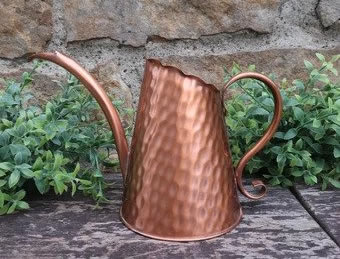
Place the plant in a sink and pour water into it generously until the soil is thoroughly wet. Don’t overdo it though and saturate the soil with water. Just enough water to thoroughly soak the plant and leave it moist at the top layer.
Allow the excess water to drain out of the pot before replacing the plant back in its usual location.
If you are watering the Hoya where it permanently sits then you should use a tray under the plant to catch the excess water. Be sure to empty the tray when all the excess water has drained out, and has accumulated in it, as Hoya hate to sit in standing water.
For most houseplants this will mean watering the Hoya every 2 – 3 weeks. But, as I mentioned previously, don’t guess – check the moisture levels in the soil.
In the winter give the plant just enough water to stop the soil from drying out completely. This will usually mean waiting double the amount of time between waterings but again, I urge you to check the soil’s moisture before watering – you will find that the soil stays moist much longer in winter.
2 Potential Hoya watering problems
I will now cover the potential problems that you can encounter with your Hoya plant when you get your watering routine wrong.
By far, when it comes to succulents and semi-succulents, the most important aspect of a plant’s care is its watering. Improper watering can cause serious problems, especially when it comes to overwatering.
Succulents and semi-succulents are usually drought-resistant but this does not mean they can survive indefinitely without sufficient water. These type of plants are drought-resistant not because they need less water than other plants but merely because they store water in their outer foliage for long-term use. If they don’t get enough water to do this they will dehydrate.
How to identify an underwatered Hoya
You must be very careful when diagnosing both underwatering and overwatering in a Hoya. What is surprising to many new indoor gardeners is that both underwatered and overwatered plants show similar symptoms.
Why does an underwatered Hoya often look the same as an overwatered one? Well, it comes down to dehydration.
Obviously when a Hoya has been underwatered the entire plant will become dehydrated. I will outline what this looks like in the next section. However, when a Hoya is overwatered it will also become dehydrated.
How can a plant become dehydrated when it is getting too much water?
When you overwater a Hoya the plant’s root will end up in standing water. This water then rots the roots (causing a disease known as root rot). As the roots rot they become unable to absorb the water they are sitting in and thus they are unable to distribute that water to the rest of the plant. Hence, the plant becomes dehydrated.
So, when you see signs of dehydration in a Hoya plant do not immediately assume that it is due to underwatering. Check for both underwatering and overwatering.
What an underwatered Hoya looks like
What should you look for in a Hoya to determine if the plant has been underwatered.
An underwatered Hoya looks similar to an overwatered Hoya – dehydrated. Wrinkled leaves and yellow leaves are often a sign of a dehydrated Hoya. As I already stated this can be due to either underwatering or overwatering though, so you must take steps to determine which is the cause. You do this by examining the soil and the roots of the plant.
Although underwatered and overwatered Hoya often look identical there are tell-tale signs of which one is the cause.
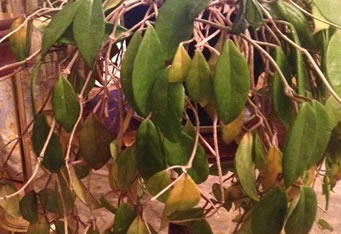
First off, check the moisture levels in the soil. If the soil is completely dry, and you know that the plant has been watered less than every 3 weeks then the chances are extremely high that your Hoya is underwatered.
As I am about to cover now, if the soil still has moisture in it but your Hoya is showing signs of dehydration then you have a much more serious problem to deal with.
How to identify an overwatered Hoya
Hoya overwatering is a serious problem. Most times it will end with the loss of the plant but if you treat the Hoya early enough you can save it.
You know you have overwatered your Hoya if the plant shows signs of dehydration while the soil is still moist. Wrinkled or yellow leaves is a sign of dehydration. You must examine the roots for signs of root rot as this is the biggest indication of overwatering.
If you find signs that your Hoya is suffering from root rot you must take immediate action. For instructions on what to do you can follow the advice given in the article on aloe vera root rot as it applies equally well to Hoya plants.
Sometimes there can be subtle signs of overwatering on a Hoya well before serious damage done. If you have been overwatering your Hoya when it is in bloom then you will find the flowers fall off and the buds may also fall off before they even have a chance to open. Stop watering the plant immediately and review the information provided above for making changes to your watering routine.
What an overwatered Hoya looks like
What should you look for in your Hoya to see if it has been overwatered?
An overwatered Hoya looks dehydrated due to root rot. The soil will still be moist but the foliage will be wrinkled, or yellow, and dry. The roots will be blackened and mushy.
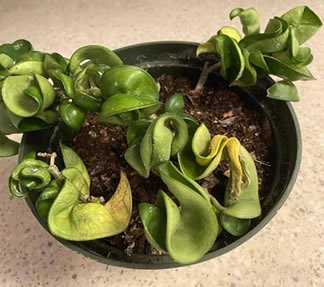
In most instances you will know that your Hoya is overwatered by the way it looks and the state of its roots.
Thanks for reading! I'm Michael — houseplant fanatic and your Pinterest plant guide.
Follow me on Pinterest for fresh updates 🌿



